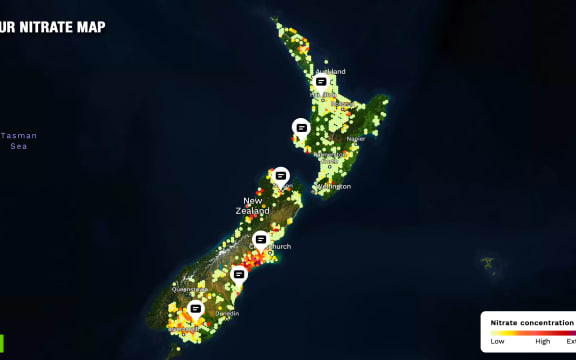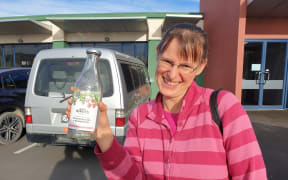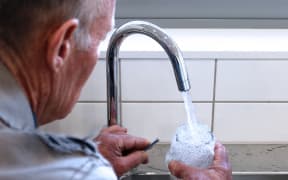
Greenpeace says it has received hundreds of requests for free mail-in drinking water testing. Photo: RNZ
Water testing in Canterbury has shown high levels of nitrate in some people's drinking water, Greenpeace Aotearoa says.
After the launch of its 'Know Your Nitrate' map late last year - which allows users to search for information on local levels - Greenpeace said it received hundreds of requests for free mail-in drinking water testing.
Following the latest round of testing, Greenpeace said 73 percent of the new data points in Canterbury were above 1mg/L. It said that was the level at which risks of bowel cancer appeared - and 39 percent were above 5mg/L, which it said could increase the risk of pre-term birth.
Canterbury Regional Council science director Dr Tim Davie said the science around the 1mg/L mentioned by Greenpeace was disputed, however, the regional council had long recognised there were high nitrate concentrations in groundwater in Canterbury.
"We continue to work closely with other agencies and landowners on this. Elevated nitrate concentrations are a key driver of change in agricultural practices, leading to better environmental outcomes. We have been working on this closely with the farming community for many years, through the nitrate leaching restrictions in our plans driving better farming practices," he said.
Greenpeace spokesperson Amanda Larsson said free drop-in water testing days were being organised in Darfield on 19 April, Culverden on 20 April, and Rangiora on 21 April.
"All you need to bring is a sample of your tap water, and we can test it for nitrate while you wait. Run your kitchen tap for one minute and fill a clean container with 200ml of water and bring it along.
"We have done free water testing in Canterbury before, but we've never been to North Canterbury. What we did find from those mail-in tests was higher readings in North Canterbury, and that's why we wanted to come back to that region."
Larsson said it would give rural communities the opportunity to know what was in their drinking water.
"Rural communities are most likely to be impacted by high levels of nitrate contamination in drinking water, because they are the closest to intensive dairying - the main source of nitrate contamination."
But they were not the only ones, she said.
"Household bore water tends to be more likely to reach higher levels of nitrate than town supply, but testing we've done in just the last year has shown several town supplies in the Canterbury region testing at more than 5mg/L of nitrate."
Greenpeace said a growing body of research had shown that even small amounts of nitrate contamination in drinking water could increase the likelihood of health risks such as bowel cancer and pre-term birth.

Greenpeace has launched an interactive map which enables people to monitor nitrate levels in their drinking water. Photo: Greenpeace Aotearoa
Larsson said there were things people could do about the nitrate in their water.
"Using a reverse osmosis filter for example, normal filters like the kind you buy in the supermarket won't remove the nitrate and boiling and chlorinating won't either, so it's quite a special kind of filter that you'd need."
But ultimately it was quite difficult to remove nitrate from water once it was in there, and the solution was to protect the water at source, she said.
"I think people in Canterbury are concerned about water quality; rivers and lakes are also polluted, and people are finding that they can't swim in the rivers that they used to be able to swim in, and then drinking water nitrate is another added concern.
"We've predominantly been advocating for a reduction in cow numbers and also a phase out of synthetic nitrogen fertiliser."
Larsson said Greenpeace's research showed Canterbury, Southland and Waikato had the highest levels of nitrate in drinking water in the country.
Dr Davie from the Canterbury Regional Council said the increase in nitrate concentrations was a result of more than a century of all types of agriculture and meat processing on the Canterbury plains and would take some time to address.
"The only way to address the issue is through reduction in nitrate leached into groundwater and this is what we, along with the agricultural community, are doing."
The regional council's website said drinking water supplied by city and district councils throughout Canterbury was generally safe.
It said councils monitored the quality of the water to make sure it was safe from pathogens, nitrate and other contaminants.





